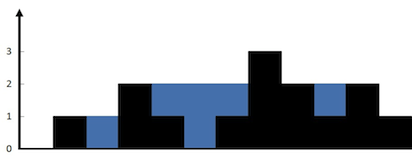- LeetCode 热题 100 - 两数之和
- 字母异位词分组
- 最长连续序列
- 移动零
- 盛最多水的容器
- 三数之和
- 接雨水
- 找到字符串中所有字母异位词
- 无重复字符的最长子串
- 和为 K 的子数组
- 滑动窗口最大值
接雨水
class 栈,数组,双指针,动态规划,单调栈给定 n 个非负整数表示每个宽度为 1 的柱子的高度图,计算按此排列的柱子,下雨之后能接多少雨水。
示例 1:

输入:height = [0,1,0,2,1,0,1,3,2,1,2,1]
输出:6
解释:上面是由数组 [0,1,0,2,1,0,1,3,2,1,2,1] 表示的高度图,在这种情况下,可以接 6 个单位的雨水(蓝色部分表示雨水)。示例 2:
输入:height = [4,2,0,3,2,5]
输出:9
提示:
n == height.length1 <= n <= 2 * 1040 <= height[i] <= 105
解法一:
/**
* @param {number[]} height
* @return {number}
*/
var trap = function (height) {
let left = 0;
let right = height.length - 1;
let sum = 0;
let leftMax = 0;
let rightMax = 0;
while (left < right) {
if (height[left] <= height[right]) {
if (height[left] >= leftMax) {
leftMax = height[left];
} else {
sum += leftMax - height[left];
}
left++;
} else {
if (height[right] >= rightMax) {
rightMax = height[right];
} else {
sum += rightMax - height[right];
}
right--;
}
}
return sum;
};说明:
要计算给定柱子高度图中的接雨水量,我们可以使用双指针的方法进行计算。这个问题通常被称为“接雨水问题”(Trapping Rain Water Problem)。
方法:双指针
算法步骤
初始化指针和变量:
左指针
left指向数组的开始位置(索引 0)。右指针
right指向数组的结束位置(索引n-1)。初始化
left_max和right_max分别为柱子高度的初始左端和右端。初始化
water_trapped变量为 0,用于存储总的接雨水量。遍历柱子高度数组:
如果
height[left]小于等于height[right]:否则:
如果
height[left]大于等于left_max,则更新left_max。否则,计算当前位置能接的水量为
left_max - height[left],并将该水量累加到water_trapped。移动左指针,即
left增加 1。如果
height[right]大于等于right_max,则更新right_max。否则,计算当前位置能接的水量为
right_max - height[right],并将该水量累加到water_trapped。移动右指针,即
right减少 1。当
left小于right时,进行以下操作:返回结果:
当循环结束时,
water_trapped即为接雨水的总量。
算法实现
下面是用 Python 实现的代码:
def trap(height):
if not height:
return 0
left, right = 0, len(height) - 1
left_max, right_max = height[left], height[right]
water_trapped = 0
while left < right:
if height[left] <= height[right]:
if height[left] >= left_max:
left_max = height[left]
else:
water_trapped += left_max - height[left]
left += 1
else:
if height[right] >= right_max:
right_max = height[right]
else:
water_trapped += right_max - height[right]
right -= 1
return water_trapped
# 示例
height = [0,1,0,2,1,0,1,3,2,1,2,1]
result = trap(height)
print("能接的雨水总量:", result)示例
输入:
height = [0,1,0,2,1,0,1,3,2,1,2,1]输出:
6
解释
在这个例子中,按照这种高度排列的柱子,经过雨水积累后,能够接住的雨水总量为 6。
复杂度分析
时间复杂度:O(n),其中 n 是柱子高度数组的长度。我们只需遍历一次数组。
空间复杂度:O(1),除了存储变量外,不需要额外的空间。
这种方法有效地利用了双指针技巧,通过一次遍历即可完成对接雨水量的计算,是解决该问题的常用方法之一。
